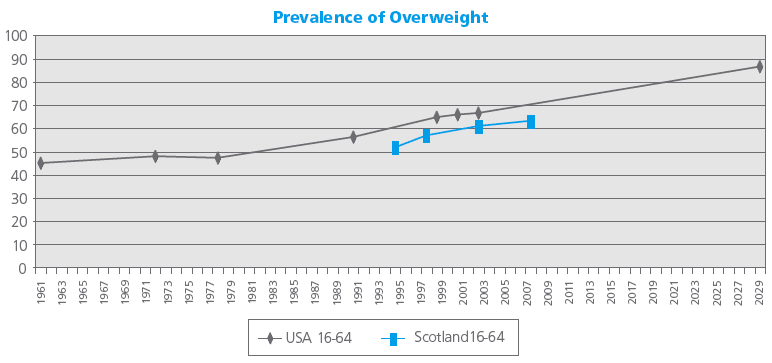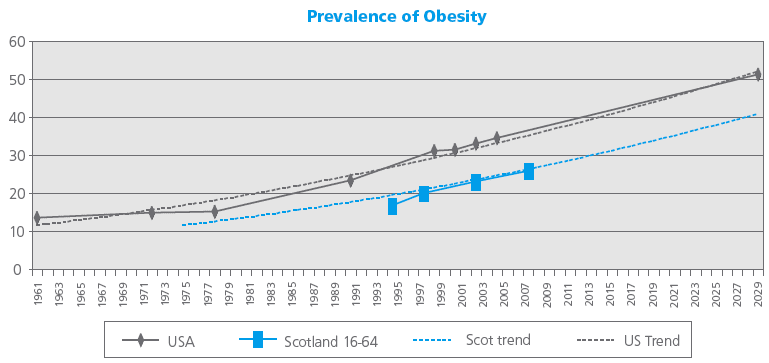Preventing Overweight and Obesity in Scotland: A Route Map Towards Healthy Weight
Scotland's obesity strategy.
APPENDIX 3: FUTURE ESTIMATES
USA trend data on obesity levels amongst adults suggest that Scotland is around 10-15 years behind the USA in terms of obesity prevalence. The levels In Scotland in 2003 (22.9%) were similar to USA levels in 1991 (23.2%). 49 The data suggest that obesity levels in the USA will reach 52% by 2030. Applying this trend to Scotland with a 12 year time lag, assuming no additional effective obesity prevention in Scotland, predicts an obesity level for the 16-64 year age group of 41% in 2030, an increase of 58% over 2008 levels. When adjusted to reflect levels in the 16+ population, the projection becomes 43%.


The predicted prevalence of obesity in Scotland in 2030 and information from the Scot PHOs' report 'Obesity in Scotland: an Epidemiological Briefing, 2007' on the proportions of different diseases attributable to obesity in 2003 can be used to derive estimates of the additional number of people with long term conditions in 2030. As the morbidly obese ( BMI > 40) group are predicted to rise at the fastest rate, 50 these are conservative estimates.
Increased prevalence of diseases associated with predicted increases in obesity levels, 2030 assuming no effective obesity prevention
Condition |
2003 |
2030 |
|||
|---|---|---|---|---|---|
Total cases |
Total cases attributable to obesity (%) |
Total cases |
Total cases attributable to obesity (%) |
Predicted increase due to obesity |
|
Hypertension |
1,351,185 |
488,496 (36%) |
1,730,561 |
867,872 (50%) |
379,376 |
Angina Pectoris |
249,909 |
40,151(16%) |
281,091 |
71,333 (25%) |
31,182 |
Type 2 diabetes |
139,881 |
87,216 (62%) |
207,615 |
154,950 (75%) |
67,734 |
Myocardial infarction |
133,869 |
27,111(20%) |
154,924 |
48,166 (31%) |
21,055 |
Stroke |
92,252 |
6,174(7%) |
97,047 |
10,969 (11%) |
4,795 |
In addition, obesity also is a major contributory cause of certain cancers (including cancers of the colon, rectum, prostate, endometrium, breast and ovary), osteoarthritis, gout and gallstones. The prevalence of all of these conditions is predicted to rise by 2030.
The consequences of obesity will perpetuate social inequalities in health in Scotland, as the conditions attributable to obesity are associated with significant current social inequalities:
- Recent work shows a flattening of the decline in mortality from coronary heart disease in the two most deprived fifths of younger adults in Scotland. The authors concluded that "unfavourable trends in the major risk factors for coronary heart disease (smoking and poor diet) provide the most likely explanation for these inequalities. 51
- Type 2 diabetes has been shown to be strongly related to deprivation. 52
- Survival after stroke in the under 65s has been shown to be related to deprivation. 53
Cost implications 2030
Using predicted increases in the conditions associated with obesity and unit costs from 2007/8, the direct cost to NHSScotland of obesity is estimated to be more than £342 million per year, almost doubling current expenditure. This figure assumes no change in current treatment practice for obesity, such as increases in use of pharmacological products or an increase in the numbers of people undergoing bariatric surgery.
Furthermore, the predicted cost of overweight has been estimated at a further £172 million. The total cost to NHSScotland in 2030 of obesity and overweight is therefore predicted to be more than £0.5 billion.
Applying the ratio of direct to indirect costs estimated in 2007/8 (1.6:1), gives indirect costs of £548 million and the resulting total cost to Scottish society of obesity in 2030 as £890 million. This is very likely to be an underestimate as sickness absence levels and premature deaths associated with obesity will rise.
Using literature estimates for the ratio of indirect to direct costs (between 2.4 and 7) gives a range of indirect costs to Scottish society from £1.2 billion-£2.7 billion. The resulting total cost to Scottish society could therefore be as high as £3 billion.
There is a problem
Thanks for your feedback